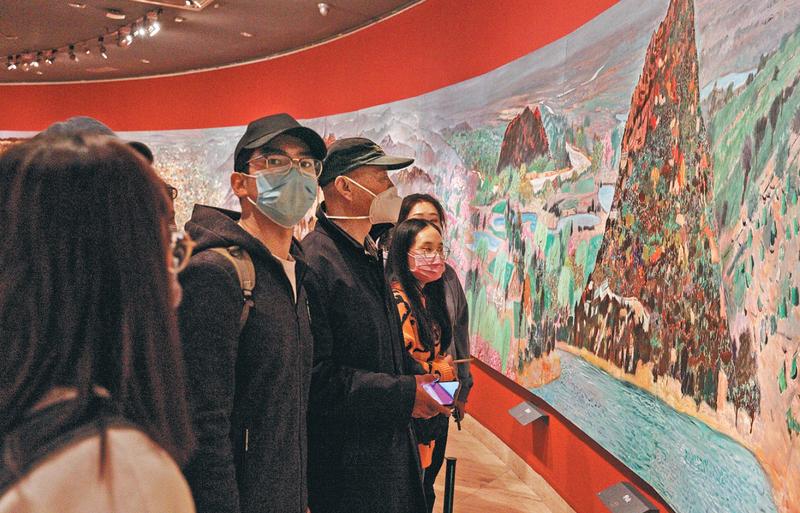Artist gifts his epic 161-meter, 101-canvas rendering of the mighty Yellow River to the National Art Museum of China, Lin Qi reports.
 A section of oil painter Wang Keju's Yellow River depicts a view of the Hukou Waterfall. A shortened version of the piece is on show at the Museum of Contemporary Art Yinchuan in Ningxia Hui autonomous region. (PHOTO PROVIDED TO CHINA DAILY)
A section of oil painter Wang Keju's Yellow River depicts a view of the Hukou Waterfall. A shortened version of the piece is on show at the Museum of Contemporary Art Yinchuan in Ningxia Hui autonomous region. (PHOTO PROVIDED TO CHINA DAILY)
The Yellow River, regarded as China's "mother river" and the cradle of Chinese civilization, is one of the most widely depicted subjects in Chinese fine arts. The 5,460-kilometer river abounds in magnificent natural views and the dynamic cultures of grassroots communities in the extensive regions it flows through, nurturing and inspiring the minds of artists throughout generations.
Wang Keju, an oil painter and retired professor of Renmin University of China's School of Arts, invested four years to complete an epic work praising the Yellow River, which he says represents a spirit of perseverance in the cultural DNA of Chinese people over the centuries.
The work titled Yellow River is an imposing 161 meters in length, and includes 101 oil paintings, each standing 2 meters.
Wang recently donated this collection of paintings to the National Art Museum of China in Beijing. Meanwhile, a shortened, watercolor version of the work-a mere 23 meters long-is now on show at The Endless Life exhibition through Jan 31, at the Museum of Contemporary Art Yinchuan, in Ningxia Hui autonomous region.
Production of the piece took Wang, a native of Shandong province where the Yellow River empties into the Bohai Sea, on several extensive trips to areas along the river. He says the process was a test of his two decades of artistic accumulation, and it also intensified his understanding of the geography of the Yellow River system, as well as the history of the cultures that have emerged along it.
"Paint brushes were my tools to measure and worship the scope and extent of the Yellow River. It was like Tibetans prostrating themselves on the ground, pace by pace, on a pilgrimage," Wang says. "And it makes me feel proud to belong to this land."
The idea of producing a panoramic view of the Yellow River first came to Wang in 2009, when he was traveling and sketching in Qikou, a historic town in Shanxi province, through which the river passes.
 People take a look at painter Wang Keju's epic work Yellow River during its donation ceremony at the National Art Museum of China on Oct 15. (JIANG DONG / CHINA DAILY)
People take a look at painter Wang Keju's epic work Yellow River during its donation ceremony at the National Art Museum of China on Oct 15. (JIANG DONG / CHINA DAILY)
Wang spent years afterward preparing for the ambitious project. He read books and watched documentaries, so that he could plan an itinerary covering important sites along the river that he needed to visit and sketch. He worked on more large-sized works to improve his techniques in commanding a bigger canvas.
Wang says the project required a journey to the source of the Yellow River in the hinterland of high-altitude Qinghai province in Northwest China. He went to Nyingchi in Tibet-located over 3,000 meters above sea level and boasting a humid, pleasant climate-to see if he could adapt to similar natural conditions.
Between June 2016 and September 2019, Wang traveled to eight provinces and autonomous regions to cover over 30 scenic sites along the Yellow River. He utilized highly saturated colors to compose a vibrant symphony on canvas: It begins with the tranquil beauty of the lakes and grasslands in the Bayan Har Mountains where the river originates, and presents a variety of breathtaking landscapes featuring distinctive geographic features in the middle and lower stretches of the river.
"Sometimes, the Yellow River roars like a galloping dragon, ready to defeat anyone who dare to confront it. Sometimes it rests peacefully like an aged wise man who has experienced the vicissitudes of history. And other times, it greets people like a vigorous, beautiful girl," Wang says.
He says the most unforgettable place is the Xingxiuhai Lake in Qinghai, believed in ancient China to be the origin of the Yellow River. "It is remote and difficult to pinpoint on a map. The roads were bumpy and we had to sleep overnight in our cars. The memories of such a dangerous journey still haunt me from time to time.
"This body of work should not be in someone's personal possession. It belongs to the nation and all of its people," Wang says, explaining the reason for his donation to the National Art Museum.
Wu Weishan, the National Art Museum's director, says Wang's work captures the primitive beauty and true nature of a grand river. "He pays tribute to the past glories and pains of the mother river, and also renders to her a modern spirit, unity, hard work and devotion.
"By doing so, he further reveals the vigor of a nation with a long history and the ability to revive itself."
Contact the writer at linqi@chinadaily.com.cn


